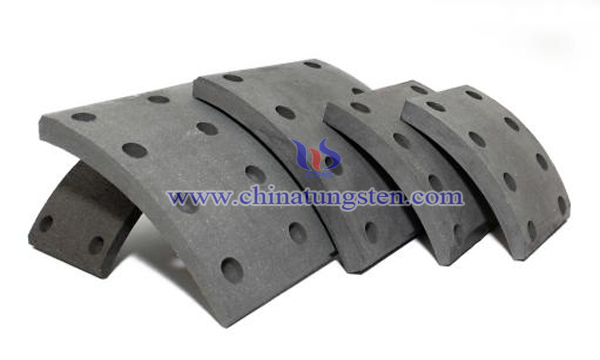Synthesis of Tungsten Boride-Silicon Carbide-Carbon Fiber Friction Material
- Details
- Category: Tungsten Information
- Published on Sunday, 04 August 2019 20:31
At present, the main friction materials are carbon fibers and carbon composites. Because the wear resistance of carbon composites is relatively low and easy to wet, people are looking for friction materials with higher wear resistance.

It is found that a kind of friction material with high strength, high friction property and adaptability to various climatic conditions is composed of carbon fibers and silicon carbide, tungsten boride and silicon nitride. The preparation method is that graphitized carbon fibre blankets with density of 0.1-1.8g/cm3 are carburized, then filled with ultrasonic dispersed tungsten boride. Ultrasound dispersed tungsten boride-silicon carbide-carbon fiber friction material was prepared by depositing silicon carbide, then burying and infiltrating silicon, then nitriding in nitrogen atmosphere.
(1)Carbon fiber blanket with density of 1.8g/cm3 was graphitized and mixed with propane and nitrogen at 900 ℃. The molar ratio of propane to nitrogen was 1:4, and the flow rate was controlled at 50ml/min. Carburized carbon fiber blanket was obtained 24 hours after carburizing treatment.
(2)The above-mentioned carburized carbon fiber blanket is immersed in slurry with fineness less than 0.3 micron and 5% tungsten boride content, placed in an ultrasonic cleaner and treated with tungsten boride for 50 minutes. After drying, the tungsten boride filled carbon fiber blanket is prepared. The slurry is aqueous solution containing 1.5% ammonium polyacrylate and pH 9.
(3)The above filled tungsten boride carbon fiber blanket was injected into the mixture of trichloromethylsilane gas, hydrogen and argon at 900 ℃. The molar ratio of trichloromethylsilane gas to argon gas was 1:5:5, the flow rate was controlled at 50 ml/min, and the silicon carbide carbon fiber blanket was deposited 24 hours after treatment.
(4)Siliconized carbon fiber blankets were prepared by immersing the deposited SiC carbon fiber blankets in the infiltrated silica material and infiltrating the siliconized carbon fiber blankets for 5 hours at 1500 ℃ in the vacuum atmosphere. Among them, the siliconized carbon fiber blankets were made by mixing 30% silicon powder, 70% carbon particles with 0.5 mm diameter and 0.2% polyvinyl alcohol solution with 5% concentration uniformly and drying.
(5) Tungsten boride-silicon carbide-carbon fiber friction material was prepared by nitriding the siliconized carbon fiber blanket at 1700 ℃ for 10 hours.
Carburizing and deposition of silicon carbide are two steps to protect the surface of carbon fibers from damage. Carbon coatings and silicon carbide coatings are deposited on the surface of carbon fibers, because silicon carbide coatings will block the infiltration of silicon vapor in the process of siliconizing. Once the silicon carbide coatings leak, the carburized coatings react with silicon vapor to form carbonization. Silicon further blocks silicon vapor, thus protecting the surface of carbon fibers from damage; filling the voids of carbon fibre blankets by filling tungsten boride and embedding silicon will be very convenient, time-saving and labor-saving, while filling tungsten boride can further improve the wear resistance of friction materials and greatly improve the working face resistance of friction materials. Temperature improves the performance and service life of friction materials.
- Tungsten Carbide Manufacturer & Supplier, Chinatungsten Online: tungsten-carbide.com.cn
- Tungsten News & Prices of China Tungsten Industry Association: www.ctia.com.cn
- Molybdenum News & Price: news.molybdenum.com.cn
- Tel.: 86 592 5129696; Fax: 86 592 5129797; Email: sales@chinatungsten.com



 sales@chinatungsten.com
sales@chinatungsten.com